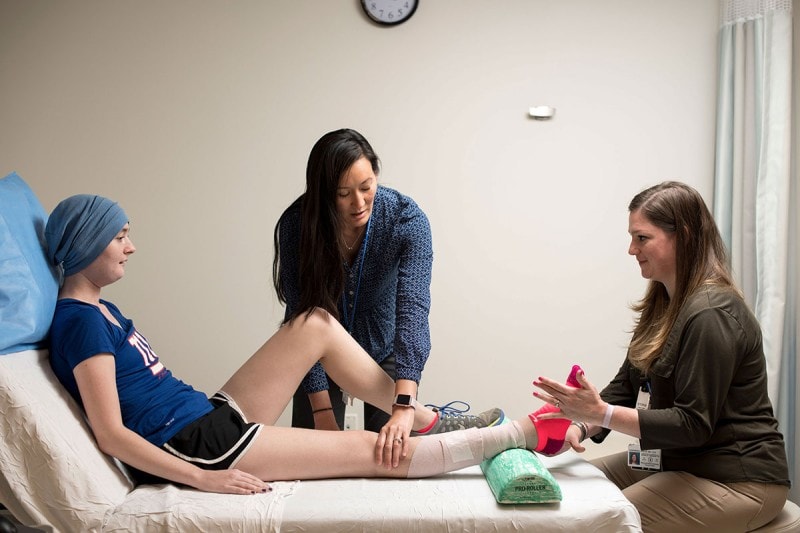How to Manage Pain During Cancer Treatment

Pain management during cancer treatment is a crucial aspect of care that requires a comprehensive approach. This article aims to provide an objective overview of various strategies for managing pain in cancer patients.
It will explore the different types of cancer pain, including both physical and psychological components, and discuss non-pharmacological techniques, medications, and integrative therapies that can be used to alleviate pain.
Additionally, the importance of effective communication with healthcare providers will be emphasized for optimal pain management outcomes.
Key Takeaways
- Cancer pain can originate from different sources, including tissue damage, inflammation, tumor growth, and nerve damage.
- A multimodal approach to pain management, combining pharmacological and non-pharmacological techniques, is often necessary for effective pain relief.
- Non-pharmacological pain management techniques, such as physical therapy, acupuncture, relaxation techniques, and cognitive-behavioral therapy, can be beneficial in alleviating cancer-related pain.
- Medication dosage adjustment, individualized for each patient based on factors like age and overall health, is crucial for optimal pain management outcomes. Additionally, alternative methods of pain relief, such as acupuncture, massage therapy, meditation, and herbal supplements, can be considered for patients who do not tolerate or respond well to traditional medications.
Understanding the Different Types of Cancer Pain
The different types of cancer pain can be categorized into nociceptive (somatic and visceral) and neuropathic pain.
Nociceptive pain arises from tissue damage, inflammation, or tumor growth and can be further classified into somatic and visceral pain. Somatic pain originates from the skin, muscles, bones, or connective tissues, while visceral pain originates from the internal organs.
Neuropathic pain, on the other hand, results from nerve damage or dysfunction caused by the tumor or its treatment.
Managing cancer pain often involves a multimodal approach, combining pharmacological and non-pharmacological techniques.
Non-pharmacological techniques, such as physical therapy, acupuncture, relaxation techniques, and cognitive-behavioral therapy, can help alleviate pain and improve patients’ overall well-being.
These techniques provide additional options for pain management and may be used in conjunction with medication to achieve optimal pain control for cancer patients.
Exploring Non-Pharmacological Pain Management Techniques
Exploring non-pharmacological techniques can offer alternative approaches for pain management in the context of cancer treatment. Non-pharmacological interventions encompass a range of strategies that do not involve the use of medication. These techniques can address the physical, psychological, and emotional aspects of pain experienced by individuals with cancer.
Taking a holistic approach to pain management involves considering the whole person and their unique circumstances rather than solely focusing on the physical symptoms. Non-pharmacological interventions commonly used include relaxation techniques, such as deep breathing exercises, meditation, and guided imagery, as well as physical therapies like acupuncture, massage, and physical exercise. Psychological interventions, such as cognitive-behavioral therapy and mindfulness-based stress reduction, can also be effective in managing cancer-related pain.
Integrating non-pharmacological interventions into cancer treatment plans can provide individuals with additional options for pain management and improve their overall well-being.
Medications and Pain Relief: Finding the Right Balance
This discussion will focus on two key points related to medications and pain relief: medication dosage adjustment and alternative pain relief.
Medication dosage adjustment is crucial in achieving optimal pain management outcomes, as individual patients may require different dosages based on factors such as age, weight, and overall health.
Additionally, alternative pain relief methods can offer viable options for patients who may not tolerate or respond well to traditional medications, providing a more personalized approach to pain management.
Medication Dosage Adjustment
Dosage adjustment of medications during cancer treatment is an important consideration in managing pain. The effectiveness of medications and individual pain tolerance can vary greatly among patients. It is crucial to strike a balance between providing adequate pain relief and minimizing potential side effects. Dosage adjustments may be necessary to achieve optimal pain control while avoiding medication toxicity.
To illustrate the complexity of medication dosage adjustment in cancer pain management, the following table presents a hypothetical scenario involving two patients with different pain tolerances and medication effectiveness. The table highlights the need for individualized approaches to dosage adjustment based on factors such as pain intensity, response to medication, and potential drug interactions.
| Patient | Pain Tolerance | Medication Effectiveness |
|---|---|---|
| A | High | Moderate |
| B | Low | High |
Alternative Pain Relief
Alternative methods of pain relief have been investigated to supplement traditional medication approaches in the management of pain during cancer treatment. These alternative options aim to provide additional relief and improve the overall well-being of patients. Some of the holistic remedies that have shown promise in relieving cancer-related pain include:
- Acupuncture: This ancient Chinese practice involves inserting thin needles into specific points on the body to stimulate the release of endorphins and promote pain relief.
- Massage therapy: This hands-on technique can help reduce muscle tension, improve blood circulation, and release feel-good hormones, which can alleviate pain.
- Meditation: By focusing the mind and practicing deep breathing exercises, meditation can help individuals manage pain by promoting relaxation and reducing stress.
- Herbal supplements: Certain herbs and botanical extracts, such as ginger and turmeric, have anti-inflammatory properties and may provide pain relief when used under the guidance of a healthcare professional.
These alternative methods of pain relief offer additional options for individuals undergoing cancer treatment, allowing for a more comprehensive approach to pain management.
Seeking Support: Emotional and Psychological Strategies for Pain Management
This discussion will focus on two key strategies for managing pain: group therapy and mind-body techniques.
Group therapy for pain involves individuals with similar conditions coming together in a supportive environment to share their experiences and learn coping strategies.
On the other hand, mind-body techniques aim to harness the connection between the mind and the body to alleviate pain through practices such as meditation, deep breathing, and guided imagery.
Group Therapy for Pain
Group therapy has emerged as a potential intervention for managing pain during cancer treatment. This approach offers various benefits and is considered as one of the alternative therapies to traditional pain management methods.
The following four points highlight the advantages of group therapy in pain management:
- Social support: Engaging in group therapy provides individuals with an opportunity to connect with others who are going through similar experiences. This social support can help alleviate feelings of isolation and provide a sense of belonging.
- Validation: Sharing experiences and emotions in a group setting can help individuals feel validated and understood. It can also provide reassurance that their pain is real and valid.
- Coping skills: Group therapy sessions often include educational components that teach participants various coping skills and strategies for managing pain. These skills can be applied in daily life and contribute to better pain management outcomes.
- Emotional well-being: Group therapy can enhance emotional well-being by promoting self-expression, reducing distress, and fostering a sense of empowerment and control over one’s pain.
Mind-Body Techniques for Pain
Mind-body techniques have gained attention as potential interventions for individuals experiencing pain in the context of cancer treatment. Two commonly studied techniques are mindfulness meditation and acupuncture.
Mindfulness meditation involves training individuals to focus their attention on the present moment, without judgment. This practice aims to cultivate a non-reactive awareness of bodily sensations, thoughts, and emotions. Several studies have shown that mindfulness meditation can reduce pain intensity and improve overall well-being in cancer patients.
Acupuncture, on the other hand, involves the insertion of thin needles into specific points on the body. It is believed to stimulate the release of endogenous opioids and other neurotransmitters, leading to pain relief. While some studies suggest that acupuncture may be effective in reducing cancer-related pain, more research is needed to establish its efficacy and optimal treatment protocols.
Integrative Therapies: Complementary Approaches to Alleviating Pain
Integrative therapies encompass a range of complementary approaches that have shown potential in alleviating pain associated with cancer treatment. Complementary therapies are used in conjunction with conventional medical treatments to enhance overall well-being and improve pain management for cancer patients.
These therapies include acupuncture, massage therapy, mind-body techniques, and herbal remedies. Acupuncture involves the insertion of thin needles into specific points on the body to stimulate energy flow and promote pain relief. Massage therapy utilizes manual manipulation of the body’s soft tissues to reduce muscle tension and promote relaxation. Mind-body techniques, such as meditation, yoga, and mindfulness, focus on the connection between the mind and body to reduce stress and promote pain management. Herbal remedies involve the use of plant-based substances, such as ginger or turmeric, to alleviate pain and inflammation.
These complementary approaches can offer additional support and symptom relief for cancer patients undergoing treatment.
Communicating With Your Healthcare Team: Advocating for Effective Pain Management
Effective communication with healthcare professionals is crucial in advocating for optimal pain management strategies. When advocating for change in pain management, it is important to effectively communicate with the healthcare team. This can be achieved through the following strategies:
- Establishing a trusting relationship with the healthcare professionals by actively listening and asking questions.
- Clearly articulating the pain experience, including the location, intensity, and impact on daily activities.
- Sharing personal goals and preferences for pain management, such as non-pharmacological interventions or specific medications.
Frequently Asked Questions
Are There Any Alternative Therapies or Treatments That May Help Manage Pain During Cancer Treatment?
Alternative therapies and non-pharmacological options are being explored to manage pain during cancer treatment. These approaches aim to provide additional relief and improve overall well-being, but their efficacy and safety need further investigation.
How Can I Effectively Communicate My Pain Levels and Concerns to My Healthcare Team?
Effective communication of pain levels and concerns to the healthcare team is crucial. Patients should use validated pain assessment tools and provide detailed descriptions of their pain, including its intensity, location, and impact on daily activities, to ensure appropriate management and support.
Is It Possible to Manage Cancer Pain Without Relying Solely on Medications?
Non pharmacological approaches, such as holistic pain management, can be used to manage cancer pain. These methods aim to address pain through a variety of techniques, such as relaxation exercises, acupuncture, and physical therapy.
What Are Some Self-Care Strategies That Can Be Implemented Alongside Pain Management Techniques?
Self-care strategies and complementary therapies can be implemented alongside pain management techniques. These strategies aim to provide additional support and relief, enhancing the overall management of pain during cancer treatment.
How Can I Address the Emotional and Psychological Impact of Chronic Pain During Cancer Treatment?
Addressing the emotional and psychological impact of chronic pain during cancer treatment requires a multifaceted approach. Providing emotional support through counseling and support groups, as well as implementing coping strategies such as relaxation techniques and mindfulness, can help alleviate these effects.









